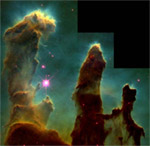|
|
Stars
Colours Lifecycle H-R Diagram LinksColour and temperatureFirst, think of a light bulb connected to a laboratory power supply or a light with a dimmer switchAs you increase the amount of electricity flowing through the filament of the light bulb, it gets hotter. As the temperature increases, the colour of the filament changes through red, orange and yellow, until it is glowing extremely brightly, and appears almost white. Click on the arrow in the picture for a demonstration. Notice what happens to the light bulb. |
|
Temperature and massHave you ever made a bonfire?Compare the amount of heat that is produced by a large pile of logs with that produced by a few of the same size. If you want to do an experiment, get adult help, and use some twigs in a barbeque or fire place. MAKE SURE YOU ACT SAFELY AND DO NOT BREAK ANY FIRE REGULATIONS. Have you ever noticed how a raging fire can consume all the available fuel very rapidly? Massive hot blue stars also burn up their fuel very quickly compared to stars with less mass. You can find out more about this in the Lifecycle and H-R Diagram sections. |


 Mrs. Mack's New Middle School Science Pages
Mrs. Mack's New Middle School Science Pages